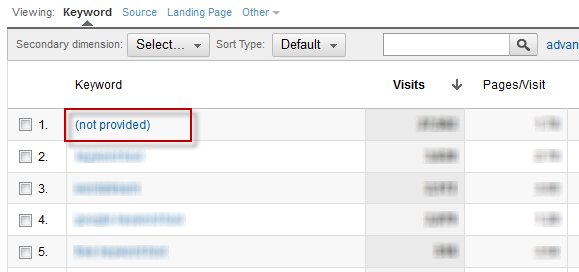Measuring SEO Without Organic Keyword Search Data from Google

Does Google Analytics say your top keyword is (not provided)?
At the end of every year, the online marketing blogs are full of predictions and lists of the biggest changes in the search engine marketing landscape in the past year. 2013 is no exception with some major changes in the Google algorithm like Penguin and Hummingbird. But the biggest impact comes from Google’s decision to stop allowing people to see exactly what search terms brought visitors to the website. Instead, for searches done while the user is logged into a Google product (Google+, Youtube, Gmail, etc) we see “(not provided)” instead of the actual search phrase in Google analytics. At first, this only applied to searches that were done by people who were logged into a Google product like Gmail, YouTube, Google Apps, etc. In September, Google confirmed that all searches will be “secured” this way soon.
This changes one of the most commonly used methods that most, if not all, SEOs have used in some way to measure the effects of their actions. Yes, conversions, leads, sales, and traffic are all still excellent ways to see if your SEO is working or not. But getting more granular about which keywords are actually bringing that traffic and where the searchers of those phrases are landing on your site has become much more difficult.
Get Ready for “Topical Optimization”
Back in April 2103, I wrote about how being too concerned with keyword rankings can be counterproductive and how we should all be looking at other results-based metrics. While I was not wrong about those other metrics being more important, I have to admit do miss being able to easily look at Google Analytics and say “Ah ha! We rank better for Blue Widgets and traffic to our page about blue widgets has increased 200%!” It was pretty easy to show the results of SEO by matching up keyword ranking positions with the amount of traffic they brought to a site.
Instead, keyword attribution is now done by combining a few different pieces of data at the page level, which works very well with the topical optimization I have been advocating, and actually doing, for the past few years. Expect to see more SEOs getting on board with this concept of optimizing for topics instead of keywords. I don’t believe I am the first to think of it, and SEOs who are on the ball are already advising similar strategies.
The general concept of optimizing for topics or themes is this:
Rather than focusing a page’s content on one keyword, a better approach is to try to rank for lots of different phrases within the same topic or theme.
When your content is well written and thoroughly covers the topic, you will open up the door to search traffic from lots of “real language” searches, which are frequently referred to as “long tail” or semantic search. You will probably also rank well for those simple keywords, too, but it will be far less critical to do so.
Matching keywords to search traffic to pages goes something like this:
- We know what topic or theme the page is about and we have optimized it that way. This won’t work if you have stuffed your favorite keyword into several different pages where it didn’t really belong.
- We know that the page ranks at certain positions for a group of keywords that fit that theme.
- The page has received a certain number of organic searches.
- Google’s Search Query data fills in some blanks about some of the other keywords that may be taking users to that page.
Now that isn’t as neat and tidy as quickly pulling up the organic keyword data in Google Analytics and making a chart or graph out of it, but believe me – a lot of people are working on solutions to make gathering and reporting that essential search traffic information a little easier. There are some non-Google sources for that keyword traffic data, too and some are very good. But none of them are as exact as the real info straight from Google Analytics once was. The keyword and traffic tracking dashboard that Ker Communications provides its clients does pull this info from a variety of sources, but still relies heavily on what Google Analytics provides, as it is usually the most accurate. At the moment, the matching of keywords to traffic in our client dashboards is not as accurate as I want it to be. Adding new analytics sources to the client tracking dashboard, or possibly changing to something new, is high on the priority list.
Should You Care About (Not Provided)?
For most website owners who aren’t terribly concerned about specific keyword data beyond rankings, this change in Google Analytics won’t mean very much. As long as that graph that shows organic search traffic keeps showing an increase, and conversions tell the same story, then it is all good.
For those who really do want or need to know the specifics of organic keyword traffic now that most or all of it is labeled as “not provided”, there are some pretty creative solutions being kicked around by some of the best data crunchers in the business.
Blue Claw recently published an article in which several very respected search engine marketing experts were asked what they are doing without the keyword traffic info. See: It’s All Going “Not Provided”
And Tim Resnik at Moz.com wrote this awesome look at Five Ways to Reclaim Your Data.
If you aren’t really into SEO or analytics, both of those articles are probably going to make your brain hurt – but at least you will have some idea about the kind of thinking and analysis that should be happening inside the head of your SEO provider.



